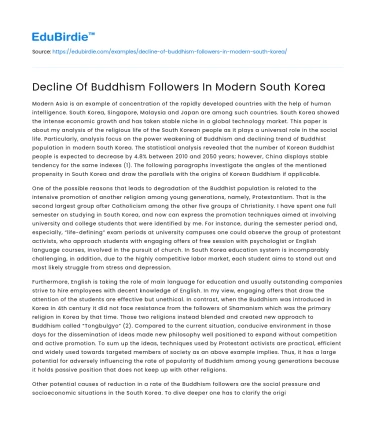Modern Asia is an example of concentration of the rapidly developed countries with the help of human intelligence. South Korea, Singapore, Malaysia and Japan are among such countries. South Korea showed the intense economic growth and has taken stable niche in a global technology market. This paper is about my analysis of the religious life of the South Korean people as it plays a universal role in the social life. Particularly, analysis focus on the power weakening of Buddhism and declining trend of Buddhist population in modern South Korea. The statistical analysis revealed that the number of Korean Buddhist people is expected to decrease by 4.8% between 2010 and 2050 years; however, China displays stable tendency for the same indexes (1). The following paragraphs investigate the angles of the mentioned propensity in South Korea and draw the parallels with the origins of Korean Buddhism if applicable.
One of the possible reasons that leads to degradation of the Buddhist population is related to the intensive promotion of another religion among young generations, namely, Protestantism. That is the second largest group after Catholicism among the other five groups of Christianity. I have spent one full semester on studying in South Korea, and now can express the promotion techniques aimed at involving university and college students that were identified by me. For instance, during the semester period and, especially, “life-defining” exam periods at university campuses one could observe the group of protestant activists, who approach students with engaging offers of free session with psychologist or English language courses, involved in the pursuit of church. In South Korea education system is incomparably challenging, in addition, due to the highly competitive labor market, each student aims to stand out and most likely struggle from stress and depression.
Save your time!
We can take care of your essay
- Proper editing and formatting
- Free revision, title page, and bibliography
- Flexible prices and money-back guarantee
Furthermore, English is taking the role of main language for education and usually outstanding companies strive to hire employees with decent knowledge of English. In my view, engaging offers that draw the attention of the students are effective but unethical. In contrast, when the Buddhism was introduced in Korea in 4th century it did not face resistance from the followers of Shamanism which was the primary religion in Korea by that time. Those two religions instead blended and created new approach to Buddhism called “Tongbulgyo” (2). Compared to the current situation, conducive environment in those days for the dissemination of ideas made new philosophy well positioned to expand without competition and active promotion. To sum up the ideas, techniques used by Protestant activists are practical, efficient and widely used towards targeted members of society as an above example implies. Thus, it has a large potential for adversely influencing the rate of popularity of Buddhism among young generations because it holds passive position that does not keep up with other religions.
Other potential causes of reduction in a rate of the Buddhism followers are the social pressure and socioeconomic situations in the South Korea. To dive deeper one has to clarify the original faith mechanisms of Buddhism. It does not impose strict living rules but gives the purpose of life, and the notion of happiness is not related to the material wealth. Following the philosophy proposed by Buddha becomes harder as the modern capitalistic world considers a monetization of almost all aspects of our life. Therefore, people of capitalistic societies strive for material well-being as the first step towards the happiness. Additionally, Buddhism does not propose instant moral reward from worshiping, instead it provides followers with the philosophy of living to achieve happiness and avoid suffer. In comparison, monotheistic religions, that practice worshiping and consider God as the creator with unlimited power, provide people with opportunities to share their concerns and ask for divine help. Going back to the social aspects of life, to emphasize high stress level in South Korea I must put forward that it has one of the highest suicide rates in the world, which is mostly caused by the depression or in other words loss of meaning of life. So, noting the difference between Buddhism and other religions, in my point of view, monotheistic religions among which Christianity is the most prevalent in Korea assure better stress relief and provide written religious texts which may assist to find the purpose of life with less effort.
All in all, paragraphs reveal some aspects of tendencies in religious development in South Korea. On the one side modern promotion techniques that play tangible role in development-oriented information society, on the other side aspects specific to each religion. From my perspective, latter has more future oriented power. To clarify, millennial generation consists of members characterized by instant gratification inclined people. Consequently, Buddhism that originally puts forward life philosophy described in four principles built around suffering and self-restraint does not meet the needs of younger generation; however, many monotheistic religions are able to provide relatively quick and accessible solutions. To conclude, above-mentioned personal analyses cover minor aspects related to complicated topic and in order to confidently indicate grounds of such tendency comprehensive research must be conducted.






 Stuck on your essay?
Stuck on your essay?

